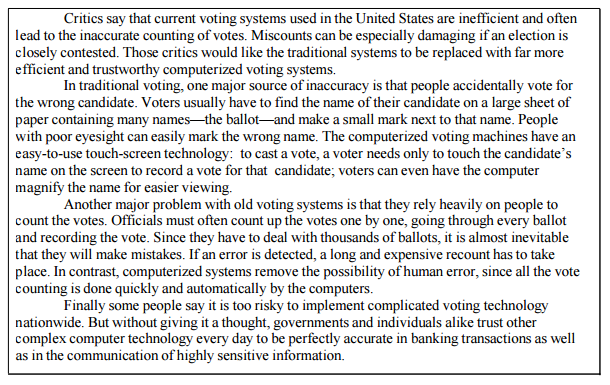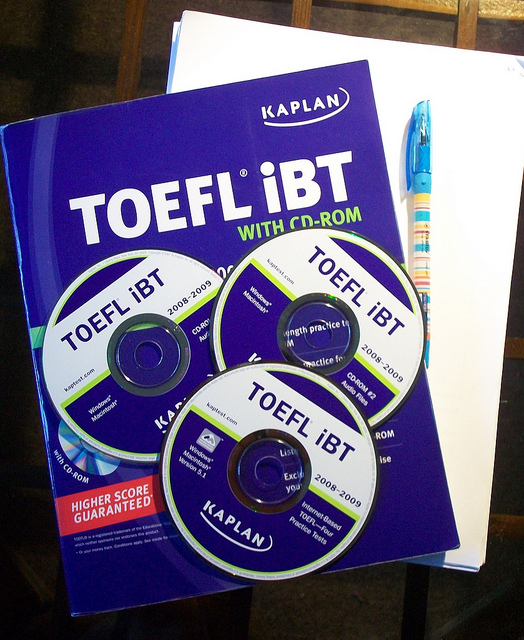
Writing English essays can be difficult for non-native speakers—especially on TOEFL Integrated Writing. For this task, you must compose a short essay comparing a lecture with a reading passage. And to get a high Integrated Writing score, you’ll need to know which resources to use as well as how to prepare effectively for the task.
In this guide, we’ll explain what TOEFL Integrated Writing entails and go over the best resources you can use for quality TOEFL Integrated Writing topics and practice. In addition, we give you six key tips to help you get the Integrated Writing score you deserve.
What Is TOEFL Integrated Writing?
There are two Writing tasks on the TOEFL: an Integrated Writing task and an Independent Writing task. The Integrated Writing task, which comes first, requires you to combine multiple skills. You must not only be able to write in English but also be able to read and listen to it. By contrast, the Independent Writing task only requires you to read a brief prompt and then write an essay explaining your opinion on the topic.
So what exactly does the Integrated Writing task entail? You’ll start by reading an academic passage. This passage is about 300 words long, and you’ll have three minutes to read it.
Next, you’ll listen to an audio clip of a professor giving a lecture on the same topic as that of the passage. This lecture will usually be about two minutes long and will either agree or disagree with points made in the passage.
Finally, you’ll have 20 minutes to plan and compose a short essay of about 150-225 words. This essay must summarize the points made in the lecture and explain how they support or challenge what’s written in the passage. You will not write about your own opinion for this task (though you will for the Independent Writing task).
As you write, you’ll be able to look at the reading passage again if you need to. (You can also finish reading it during this time if you didn’t get to do so before.) However, you may not listen to the audio clip again. This is why it’s best to take notes while you listen to the audio clip (we’ll talk more about how to do this later).
By the way: we have built the world's best online TOEFL course. Get online practice (TPO-sytle!) and individual grading and feedback on Speaking and Writing.
To be fair, it's possible to get a good TOEFL score studying alone. But PrepScholar is the world's most effective TOEFL course if you are worried about the TOEFL and are struggling to improve your score.
Learn how you can improve your TOEFL score by 15 points today.
Now, let’s turn our attention to scoring. The Integrated Writing task—like the Independent Writing task—is scored on a scale of 0-5. According to the official rubric, a 5 response “successfully selects the important information from the lecture and coherently and accurately presents this information in relation to the relevant information presented in the reading.”
On the other hand, a 1 response “provides little or no meaningful or relevant coherent content from the lecture.” (Note that a score of 0 means you did not fulfill the prompt correctly—for example, you copied sentences from the passage, wrote in a foreign language, or didn’t write anything at all.)
After, your Integrated and Independent scores are combined and converted to a scaled Writing score on a scale of 0-30 (i.e., the same scale used for all sections of the TOEFL).
Here is an example of a complete TOEFL Integrated Writing task:
Read the following passage and the lecture which follows. In an actual test, you would have 3 minutes to read the passage. Then, answer the question. In the test, you would have 20 minutes to plan and write your response. Typically, an effective response will be 150 to 225 words. Test takers with disabilities may request additional time to read the passage and write the response.
READING PASSAGE

LECTURE TRANSCRIPT
(Narrator) Now listen to part of a lecture on the topic you just read about.
(Female professor) While traditional voting systems have some problems, it’s doubtful that computerized voting will make the situation any better. Computerized voting may seem easy for people who are used to computers. But what about people who aren’t? People who can’t afford computers, people who don’t use them on a regular basis—these people will have trouble using computerized voting machines. These voters can easily cast the wrong vote or be discouraged from voting altogether because of fear of technology. Furthermore, it’s true that humans make mistakes when they count up ballots by hand. But are we sure that computers will do a better job? After all, computers are programmed by humans, so “human error” can show up in mistakes in their programs. And the errors caused by these defective programs may be far more serious. The worst a human official can do is miss a few ballots. But an error in a computer program can result in thousands of votes being miscounted or even permanently removed from the record. And in many voting systems, there is no physical record of the votes, so a computer recount in the case of a suspected error is impossible! As for our trust of computer technology for banking and communications, remember one thing: these systems are used daily and they are used heavily. They didn’t work flawlessly when they were first introduced. They had to be improved on and improved on until they got as reliable as they are today. But voting happens only once every two years nationally in the United States and not much more than twice a year in many local areas. This is hardly sufficient for us to develop confidence that computerized voting can be fully trusted.
Question: Summarize the points made in the lecture, being sure to explain how they oppose specific points made in the reading passage.

14 Resources for TOEFL Integrated Writing Practice
Now that you understand what a TOEFL Integrated essay entails, let’s take a look at some of the best resources you can use for TOEFL Integrated Writing topics and practice.
Note that most of these resources are geared toward the entire TOEFL test and therefore will contain practice questions and tips for other TOEFL sections as well.
Official Prep Materials
Official resources (i.e., those created by ETS) are far and away the best resources to start with when you want to find quality TOEFL Integrated Writing practice questions. All official TOEFL resources offer authentic test questions and prompts similar to those you’ll see on test day. And the best part is that many of these resources are entirely free!
TOEFL Online Practice (TPO) Tests
By far the most authentic TOEFL Integrated Writing practice you can get is through official TPO tests. These full-length TOEFL practice tests are real, retired exams and thus offer a highly realistic TOEFL Integrated Writing test-taking experience.
Once you finish a test, your Integrated essay is immediately graded by a computer. However, I’m not a huge fan of this scoring system since it isn’t clear why the computer grader assigns certain scores. By contrast, on the actual TOEFL, your Integrated Writing task will be graded by a combination of human raters and a computer.
Unfortunately, each TPO test is quite costly: 45.95 USD. So don’t buy one of these tests unless you’re 100 percent sure it’ll help you on the Integrated Writing task and other sections of the exam as well.
TOEFL iBT Interactive Sampler
One of the best TOEFL practice resources you can use is the TOEFL Interactive Sampler. This free, downloadable software contains an abbreviated TOEFL test, complete with a full Writing section.
What’s especially great is that the Integrated Task comes with three sample responses: a high-level response, a mid-level response, and a low-level response. These are helpful in that they show you what kinds of details, structures, grammar, and vocabulary you’ll be expected to use in your own essay.
There are a couple of downsides to this resource, though. For one, the sampler doesn’t work with Macs. Another issue is that you can’t write your essay directly in the program. Rather, once the prompt is shown, all you’re given are the three sample responses. But you can still complete the task by opening Microsoft Word or another writing program and typing your essay there.
Once you’ve finished writing your essay, I suggest either using the TOEFL Integrated Writing rubric to score your response or asking a native English speaker to grade your essay for you.
TOEFL iBT Quick Prep
This free set of four PDFs offers a ton of high-quality sample TOEFL questions, including two Integrated Writing tasks (in Volume 1 and Volume 3).
Volume 1 provides you with a transcript of the lecture instead of an audio clip, so it’s not the most realistic test-taking experience you can get. But Volume 3’s TOEFL Integrated Writing task uses an MP3 for the lecture, making it far more similar to what you’ll get on the actual test.
Since these volumes are both PDFs and not software programs, you’ll once again need to use a separate computer program to type out your responses.

Want to improve your TOEFL score? We have the world's leading TOEFL course.
Built by world-class instructors from Harvard and MIT, the course offers individual review, interactive lessons, and realistic online praactice, at an affordable price! It's the fastest way to get your target TOEFL score.
TOEFL iBT Writing Sample Responses
Another free resource by ETS, this PDF presents a number of TOEFL Integrated Writing sample responses, from low- to high-scoring ones.
With this resource, you’ll get one TOEFL Integrated Writing task with a passage and lecture transcript. And as for sample essays, you’ll get:
- Two level-5 essays
- Three level-4 essays
- Three level-3 essays
- Three level-2 essays
- Two level-1 essays
What I particularly love about this PDF is that it includes detailed feedback on why certain essays received the scores they got. Therefore, I strongly suggest reading these explanations to learn more about how ETS expects you to write and organize your Integrated essay on test day.
Official TOEFL Prep Books
Another solid option is to buy an official TOEFL prep book. Official books are excellent, comprehensive resources for TOEFL Integrated Writing practice, as well as Reading, Listening, and Speaking practice.
The Official Guide to the TOEFL Test is perhaps your best bet. This resource offers a CD-ROM with three full-length practice tests in addition to 600 practice questions.
However, its Integrated Writing information isn’t all new. For example, many of its sample scored responses are the same as those in the TOEFL iBT Writing Sample Responses PDF above. Moreover, its first practice test uses the same Integrated Writing prompt contained in the free TOEFL Interactive Sampler.
Other official prep books include Official TOEFL iBT Tests Volumes 1 and 2. Each volume contains five unique full-length practice tests, giving you a grand total of 10 Integrated Writing tasks to practice with. Unlike The Official Guide, though, which offers several sample responses for each scoring level, each Writing task here comes with just one high-scoring sample response.
Official TOEFL prep books are usually reasonably priced at around 25 USD a piece.
TOEFL iBT Sample Questions
This free, handy PDF is similar to Quick Prep but contains far fewer practice questions. With this resource, you get one Integrated Writing task (which we used above as an example).
Unfortunately, this PDF doesn’t contain any audio files, so you’ll need to read a transcript for the lecture. This, along with the lack of additional TOEFL Integrated Writing practice questions, ultimately makes this resource less realistic and less useful than some of the other ones on this list.

Unofficial Prep Materials
While official materials are hands down your best bet for quality TOEFL Integrated Writing practice, some unofficial resources offer a solid array of TOEFL Integrated Writing practice questions as well.
The problem, however, is that most unofficial TOEFL resources are low quality, so you’ll need to learn how to distinguish the ones that are worth using from the ones that aren’t. Generally speaking, a solid TOEFL resource is one that offers realistic practice questions, comprehensive answer explanations, and useful test-taking strategies.
Below are our top picks for the best unofficial resources for TOEFL Integrated Writing topics. Like our list above, the majority of resources here are completely free to use!
Unofficial TOEFL Prep Books
There are many high-quality unofficial TOEFL prep books available on the market. The key is to know which ones are worth buying—that is, which ones will offer you the most authentic TOEFL Integrated Writing tasks you can practice with. Our guide to the best TOEFL prep books includes three unofficial TOEFL prep books to consider incorporating into your prep.
As with any dense resource, unofficial TOEFL prep books come at a price. However, they’re not normally that expensive, with prices typically hovering around 10-30 USD. (That’s cheaper than one TPO test!)
Strictly English
This website offers one free Integrated Writing task as well as several additional tasks you can only access if you are a paid member. Both the passage and audio clip for the free task are extremely high quality, making it an ideal resource to include in your prep.
Strangely, the free Integrated task doesn’t include a prompt. That said, you don’t actually need a prompt to write an Integrated essay anyway, as the prompt is always the same: compare a lecture with a passage.
Another convenient feature of this website is a box that you can type your essay in. Once you finish typing, though, ignore the “Submit My Essay” button below. This feature only works for paid members, so nothing will happen if you click it.
BestMyTest
Like Strictly English, BestMyTest offers one free Integrated Writing task, though you can access many more Integrated Writing tasks with paid membership. The free task is high quality and consists of a decent reading passage and a clear, easy-to-follow audio clip.
One especially helpful feature is the timer, which makes it easier to keep track of how much time you have left for each part of the task.
Magoosh
A solid choice, Magoosh offers one TOEFL Integrated Writing task that’s fairly high quality. The reading passage is very similar to those on the TOEFL, especially in length, and the audio clip is crisp and easy to understand.
While you won’t get a lecture transcript, you will get a sample level-5 essay with an in-depth analysis of what makes this essay strong.

Want to improve your TOEFL score by 15 points?
Registration is now open for our best TOEFL course. We guarantee your money back if you don't improve your TOEFL score by 15 points or more.
PrepScholar TOEFL is online and it features thousands of practice questions and 1-on-1 Speaking and Writing review and feedback.
English Club
This free website offers one TOEFL Integrated Writing task with a passage, audio clip, and sample response. You’ll also get a transcript of the lecture, which is helpful if you’re struggling to understand any parts of it (though you won’t get a transcript on test day).
There are two drawbacks to this website, however. First, the reading passage, though good quality, is quite short. Integrated Writing passages are generally around 300 words, but the passage here is only about half that length, making it not as realistic as it could be.
In addition, the audio clip quality isn’t particularly good. The voice often sounds muffled, making it difficult to understand at times.
PrepScholar
At PrepScholar, we offer an original TOEFL Integrated Writing task, complete with a reading passage, lecture transcript, and prompt similar to what you’ll get on test day.
As with any TOEFL task, make sure to abide by the official time limits so that you’re getting as realistic practice as possible. For Integrated Writing, this means you’ll have:
- Three minutes to read the passage
- About two minutes to read the lecture transcript
- 20 minutes to plan and write a response
After you finish typing your essay on a computer, use our analysis of two high-scoring essays to grade your response and give yourself a rough idea as to how you can improve your spelling, grammar, organization, time management, and overall writing skills for the test.
Study.com
Study.com offers one TOEFL Integrated Writing task, which you can access (mostly) via a free lesson preview. Included is an entire reading passage and lecture transcript—but no prompt, as that’s where the preview gets cut off.
In reality, though, you don’t actually need a prompt since all Integrated tasks require you to do the same thing: compare a lecture with a passage. Nonetheless, if you’d like to see the full TOEFL Integrated Writing lesson, you can make an account by signing up for a free five-day trial.
TOEFL Resources
Though TOEFL Resources doesn’t offer any original Integrated Writing tasks for you to practice with, it does contain a large assortment of sample Integrated Writing essays, which you can compare with your own responses to get a better understanding of what a high-scoring TOEFL essay looks like.
Many of this website’s sample essays are based on Integrated tasks from popular TOEFL prep books, including The Official Guide and Official TOEFL iBT Tests, so if you’ve got any of these and want to see more high-scoring sample responses, this resource is definitely helpful!
What’s more, all sample essays were written by native English speakers, so you can be sure they’re grammatical and structurally solid.

How to Prepare for TOEFL Integrated Writing: 6 Tips
So far, we’ve gone over all of the major resources you can use to strengthen your TOEFL Integrated Writing practice. Now, let’s take a look at our top six tips to help you get the Integrated Writing score you want.
#1: Strengthen Your Reading & Listening Skills
Since you must read a passage and listen to an audio clip for the TOEFL Integrated Writing task, it’s important to hone your reading and listening skills in addition to your writing skills.
To get better at reading, make sure you have a broad knowledge of English vocabulary, particularly academic vocabulary. I recommend reading real-life newspapers and magazines, such as The New York Times and The Atlantic. Additionally, try reading introductory notes and paragraphs in university-level textbooks. For more tips on what to read, take a look at our guide to TOEFL Reading resources.
As for listening practice, take time to listen to spoken English by watching YouTube videos and English news channels or listening to English podcasts. Some free, helpful resources for English-listening practice include VOA Learning English and EnglishClass101.
#2: Keep a Journal
To do well on TOEFL Integrated Writing, you need to be a good writer. And to be a good writer, you need to write!
One great way to practice writing in English is to write in a journal (almost) every day. This allows you to consistently practice your writing skills and learn how to write more quickly and with better grammar.
Because you’ll be typing your Integrated essay on a computer, I recommend keeping a digital journal. You can do this online through a free website called Lang-8. On this website, users write diary entries and other notes in their target languages. These entries are then posted and corrected by native speakers of the target language.
I myself have used Lang-8 many times while studying Japanese. All in all, it’s an incredibly fun and supportive resource that also offers a convenient way to connect with others studying English like you.
#3: Memorize Useful Transitions
The best writers are those who can effectively connect their thoughts to make their writing compelling. And one of the easiest ways to do this is to use transitions.
Transitions are words and short phrases that connect ideas in writing (as well as in speech). They often come at the beginning of paragraphs and sentences and can be used to:
- Link similar ideas
- Contrast different ideas
- Emphasize ideas
We’ve compiled an extensive list of 54 transitions to use in your Integrated and Independent Writing essays. Briefly, though, here are some of the most common transitions you should know:
- First
- First off
- Second
- Secondly
- Next
- Finally
- Lastly
- In addition
- Additionally
- Also
- For example
- For instance
- However
- Therefore
- Thus
- In conclusion

#4: Do Timed Writing Exercises
You can’t expect to do well on TOEFL Integrated Writing unless you actually sit down and practice. This is why you should use the resources above (particularly the official ones) to carve out time to practice answering TOEFL Integrated Writing questions.
Each time you practice, time yourself using the official time limits for Integrated Writing. In other words, give yourself:
- Three minutes to read the passage
- About two minutes to read the lecture transcript (if not available as an audio clip)
- 20 minutes to plan and type your response
Once you’ve finished reading the passage and listening to the audio clip, begin to type your response on a computer. Although you may write out your response on paper, a computer is preferable, as it more accurately recreates the TOEFL test-taking experience. After you’ve completed a task, use the official Integrated Writing rubric to score yourself and determine what you did well—and what you could improve.
If your Integrated task comes with any sample essays, use these to help score your response. High-scoring essays can help you understand what specific details to include in your essay and what stylistic or structural features ultimately make an essay more compelling.
If possible, ask a native English speaker to offer feedback on your practice essays as well. This will give you a more objective view of the overall strength and quality of your writing.
#5: Use Scratch Paper Wisely
You’ll have scratch paper to use throughout the exam, so make sure to use it wisely on the Integrated Writing task, too.
Since you’ll only get to hear the audio clip once, use your scratch paper to take notes as you listen. (You can reread the passage, so you don’t need to take notes on it.) As you listen, write down the main point of the lecture and any important terms, concepts, steps, or examples the professor mentions.
Then, once your writing time begins, spend the first three minutes or so outlining your essay on your scratch paper. Try to jot down the three main points you want to discuss as well as any key details or examples you can use to illustrate them. Don’t get too elaborate with your outline—just get the main points down and let the rest of the details come naturally as you write.
We cover more TOEFL note-taking tips in our in-depth guide (coming soon).
#6: Follow a TOEFL Writing Template
Finally, if you’re worried about your ability to coherently structure an essay, consider practicing with a TOEFL Writing template. A template offers you a basic framework to start with, which you can then modify to suit any Integrated Writing prompt.
The benefits of a template are numerous. For one, you’ll always have a sentence opener or transition to fall back on in case you’re unsure what to write next, giving you more confidence on test day. You’ll also have a clearer idea as to how to structure your thoughts and will therefore spend less time worrying about your essay’s organization and flow.
Recap: What Is TOEFL Integrated Writing?
The TOEFL Integrated Writing task is the first of two Writing tasks. For this task, you must combine your reading, listening, and writing skills to produce a compelling essay that compares a passage with a lecture on the same topic.
In order to get a high score on TOEFL Integrated Writing, try to practice with high-quality resources. Several official resources are free and offer a broad assortment of Integrated Writing prompts. Unofficial TOEFL resources, too, can be helpful, though you’ll need to be careful with what you choose since most unofficial materials are not as reliable as official ones.
As you prepare for TOEFL Integrated Writing, be sure to do many timed writing exercises and get feedback on your practice essays. You should also:
- Strengthen your reading and listening skills
- Keep an English journal to further hone your writing skills
- Memorize transitional words you can use in your essays
- Use scratch paper to take notes on the audio clip and to outline your essay
- Consider practicing with an Integrated Writing template to help you feel more prepared for test day
What’s Next?
Want more TOEFL Writing practice? Then check out our original list of 13 TOEFL Writing topics as well as our picks for the best TOEFL Writing resources.
Aiming for a high TOEFL Writing score? Read our guide to learn what a good TOEFL Writing score is (coming soon), and then get a rundown of everything you need to know in order to ace the TOEFL Writing section.
Looking for more general TOEFL tips? Learn how to prepare for the TOEFL with our eight expert tips.
Ready to improve your TOEFL score by 15 points?
Download our best TOEFL Strategy eBook (valued at $14.49) for FREE! Learn the top 5 strategies you must know to improve your TOEFL score. Download it for free now:
